Qigong/ChoyLeeFut > Baduanjin
Baduanjin
by Howard Choy
"Baduanjin", which literally translates as "eight pieces of silken brocade", has always been a very popular exercise in China. Its unusual name derives from the fact that the Chinese character for silken brocade - 'jin' - also has the archaic meaning of that of a set of exercises composed of different movements. Hence the title "eight pieces of silken brocade" can be interpreted more accurately as "an exercise composed of eight sets of movements".
Baduanjin has a written history of over 800 years. During this period of time, many modifications and innovations have been added to the original form. Although the variations are numerous, they can be broadly categorised into themes related to the seated and to the standing postures, with the latter further sub-divided into the 'Northern' and the 'Southern' styles.
The Northern style claims its legendary founder to be Yue Fei, who was a famous general in the Sung Dynasty (960-1279AD). It is considered to be more difficult to perform than the Southern style.
This article illustrates one such Northern version, which was first published in China in 1917 by Lian Pu and Jiang Tie Ya, who were both students of the Quing Hua University at the time.
Their booklet stated that this particular version of "Baduanjin" was popular in a certain part of Henan Province and that an old man from the town of Zheng-Zhou (in Henan) taught these exercises to Lian who in turn passed it on to Jiang.
His teacher boasted to Lian once, "I am over 80 years old. All my family members (a few score at that!), irrespective of whether they are male or female, young or old, all practised Baduanjin. We have had no need for any medication in the past 40 years!"
I was taught both the Northern and the Southern versions by my Choy Lee Fut teacher, Mr Li Lu Ling, who had learned his art from the Qing Wu Association in the 1930s.
Movements of Baduanjin
To emphasise the therapeutic nature of Baduanjin, the traditional name of each of the eight sets of movements is given in poetic terms with a cryptic description of the actions involved and the benefits it entails.
Set No. 1: For example, the first set is called "Ti Di Tuo Tian Li San Jiao", which translates as 'carry Earth and support Heaven to put in order the three visceral cavities housing the internal organs (san jiao)". The Chinese character san means three; thus, san jiao refers to the three specialised groupings of the internal organs concerned mainly with the fluid transportation in the living body (including blood and qi movement). This term is peculiar to Chinese medicine. It can also be referred to as the three internal groupings of organs of the body. Thus shang (upper) jiao refers to organs above the diaphragm, including the heart and the lungs; zhong (middle) jiao refers to organs between the diaphragm and the umbilicus, including the spleen and the stomach; and xia (lower) jiao refers to organs below the umbilicus, including the kidney, the urinary bladder, the small intestine and the large intestine. Thus "to put in order the san jiao" means the exercise will massage all the internal organs and facilitate the movements of the body fluids, the blood and the qi.
The rest of the sets are translated as follows, each with a brief explanation of the Chinese medical terms involved.
Set No. 2: "Draw bow left and right as if about to shoot a bird".
This movement has its emphasis in the chest region or to put it in Chinese medical terms, the shang jiao organs referred to earlier. The contraction and expansion of the chest cavity and the muscles of the arms help to facilitate the intake of oxygen and the flow of the body fluids (blood and qi) which in turn quickens the process of regeneration of the body cells and of the muscle fibres. As a result, a feeling of tiredness will give way to a feeling of liveliness.
Set No. 3: "Take care of the spleen and the stomach by lifting the arms separately".
The spleen and the stomach, according to Chinese medicine, function as "messengers" in the transformation and the distribution of digested matter. Massaging these visceral organs internally, by stretching the arms, can help to improve digestion and the absorption of nutrients by the body.
Set No. 4: "Overcome exhaustion of the five internal organs and injuries caused by the seven human emotions, by practising looking backwards".
The Five Internal Organs referred to are the heart, the liver, the spleen, the lungs and the kidneys. The Seven Human Emotions are joy, anger, sorrow, fear, love, hatred and desire. Apart from the physical benefit through movement of the neck this exercise calms the nerves and overcomes tiredness.
Set No. 5: "Shake the head and wag the tail to remove excess heat of the heart".
Excess heat of the heart, "xin juo", is a chronic situation resulting from an overactive heart. The symptoms are feelings of constant uneasiness and of being disturbed. Some may suffer from insomnia and a constant thirst.
Set No. 6: "Carry the foot with both hands to rid the heart of its illness".
Illness of the heart refers to worry and anxiety.
Set No. 7: "Clench fists and glare with eyes wide to increase physical strength".
The stationary horse stance in this exercise enables the qi to be stored in the dantian. The tensing of the muscles and the widening of the eyes enables the qi to travel outward along the jing luo. Where the qi flows, strength follows.
Set No. 8: "(as if) Tossing back and forth on horseback to eliminate all kinds of sickness".
The name of the last set indicates the importance of exercising the body and its joints in regulating health and wellbeing.
Another of Hua Tuo's oft-quoted statements - "the hinge of a swinging door never gets wormholes" - comes to minds. The body is likened to a door hinge, bearing in mind that door hinges in Hua Tuo's day were made of wood. Inactivity leads to stasis and obstruction of qi and blood in the jing luo which further leads to disharmony and ill-health. This can be prevented by practising forms that involve body movements and qi regulation (qigong) such as Tai Chi, Lohan Gong and Baduanjin.
Points to consider while practising the Baduanjin form
- The speed should be slow and even throughout. Repeat each set twice. Gradually build it up to eight repeats per set.
- The breathing should be natural, deep, regular and even, with awareness in co-ordinating movement with breath. The breathing should not be forced or hurried nor should the breath be held.
- The movements should be performed correctly and precisely but in a relaxed manner without undue strain. The healing effects of Baduanjin can only be derived from correct execution of the form.
- The mind should be centred, free from extraneous thoughts and completely focussed on the breath and movement sequences that are being at that moment. On no account should the mind be allowed to wander.
- One must practise regularly and consistently. Ideally, the form should be completed at least once a day in quiet, natural surroundings. The optimum to practise is early morning when it is cool and the yang qi is in ascension. Avoid extremes of climate.
- The best position for general practice, unless advised for a specific healing purpose, is to face East.
Set No. 1
Preparation: Stand upright, feet together (1).
1.1. Take a side step with left foot, bend legs to form a horse-riding stance, hang both arms by the sides, fingers point downwards, eyes look forward (2).
1.2. Raise hands, level with eyebrows, fingers straight, palms face down (3).
1.3. Lower both hands close to body, at chest level close palms together, fingers pointing up. Lower palms closed until 10 to 12cm from ground. Separate palms, straighten legs, both palms press downward towards the ground (4).
1.4. Turn both elbows until palms face outward, clench fists and lift as though picking up a heavy object. Bend knees to form horse-riding stance (5).
1.5. Lift fists upward to chest level, bend elbows and turn fists (6).
1.6. Change fists to open palms, fingers straight, turn palms up as though pushing towards sky, fingers straight, eyes look towards fingertips (7).
1.7. Lower both arms, fingers point downward as for movement 1 (8).
1.8. Stand upright, feet together as for Preparation (9).
Repeat movements 1.1-1.8.
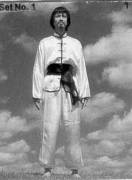







Set No. 2
Preparation: (Continue from end of previous set) take a side step with left foot, bend both legs to form a horse-riding stance, clench fist with left forearm poiting upwards. At the same time, clench right fist, forearm bent and level with chest, right fist as high as shoulder, eyes look towards left fist (10).
2.1. Straighten left arm, level with head, at the same time pull right arm towards right fist, level with shoulder. Turn head towards left, eyes look at left fist then turn to right, eyes look towards right fist (11).
2.2. Repeat preparation in opposite direction (12).
2.3. Repeat 2.1 in opposite direction (13).
2.4. Finish again with preparation (14).
Repeat movements 2.1-2.4.


Set No. 3
Preparation: (Continue from end of previous set), horse-riding stance unchanged. Hang both arms by the side, palms facing backwards, fingers pointing down, eyes looking forward (15).
3.1. Turn body to the right, move left fist to the right, forearm bent diagonally, fist face upward, at the same time move right fist to the side of the right waist, fist facing upwards, eyes looking towards left fist (16).
3.2. Bend body down, turn fists into palms, left palm dropping down towards right toe, right palm facing upwards (17), eyes looking towards left palm.
3.3. Without moving right palm, straighten up and turn left to form a left bow stance, left forearm bent upwards, fingertips pointing towards nose, eyes looking towards left fingertips (18).
3.4. Raise left palm towards sky, right palm pushing down towards earth, eyes looking towards the back of the left palm (19).
Repeat movements 3.1-3.4 (20-23).


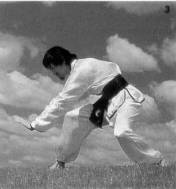



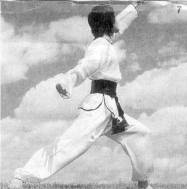
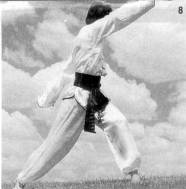
Set No. 4
Preparation: (Continue from end of previous set), turn body to left to form horse-riding stance. Bend right arm level in front of chest (above on the outside), bend left arm level in front of abdomen (below on the inside), eyes looking forward (24).
4.1. Turn body to left to form a left bow stance, separate both arms at the same time, change right fist to a palm and raise palm upwards, change left fist to a palm and press downwards, eyes looking backward (25).
4.2. Turn body to right and return to preparation, bend left and right arms in opposite direction (26).
4.3. Repeat movements from 4.1 to 4.2 in opposite directions.
4.4. (27) and (28).
Repeat movements 4.1-4.4.





Set No. 5
Preparation: (Continue from end of previous set), do not move feet, stand upright and change fists into palms by side of waist, palms facing upwards, eyes looking forward (29).
5.1. Bend body forward, keep back and legs straight, all fingers touch ground, shake head towards left, twist buttocks towards right (30).
5.2. Return to preparation (31).
5.3. Repeat as for 5.1 to 5.2 in opposite directions.
5.4. (32) and (33).
Repeat movements 5.1-5.4.




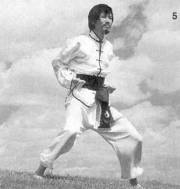
Set No. 6
Preparation: (Continue from end of previous set), close left leg and return to upright stance (34).
6.1. Carry left leg upwards with both hands, straighten legs, eyes looking forward (35).
6.2. Return to position as for preparation (36).
6.3. Repeat movement 6.1 with right leg (37).
6.4. Return to preparation (38).
Repeat movements 6.1-6.4.





Set No. 7
Preparation: (Continue from end of previous set), stand upright, feet together (39).
7.1. Take a side step with left foot, bend both legs to form horse-riding stance. At the same time, clench both fists and position them by the side of the chest, eyes looking forward (40).
7.2. Hold posture.
7.3. Hold posture.
7.4. Return to preparation (41).
Repeat movements 7.1-7.4.
Set No. 8
Preparation: (Continue from end of previous set), take a side step with left foot, bend both legs to form horse-riding stance. Clench both fists, bend arms by side of waist, fists facing upwards, eyes looking forward (42).
8.1. Lift both heels off the ground, at the same time lean forward and push out both palms frontward (the back must not be bent), eyes looking forward (43).
8.2. Return to preparation (44).
Repeat movements 8.1-8.2 twice.

